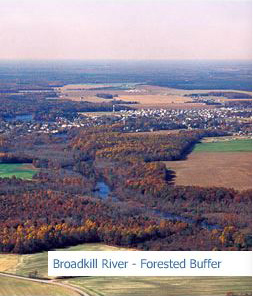Citizen Monitoring Program
2011 WATER QUALITY REPORTS AND SUMMARIES
Sept 1 - Oct 13
Here is the eighth set of UD Citizen Monitoring Reports for 2011, covering the last 6 weeks from September 1 to October 13.
- After getting swamped by Hurricane Irene in late August, the rain from Tropical Storm Lee mostly fell further inland in early September, and precipitation for September was near average. So far, October has been rather dry. Extended periods of cool and cloudy conditions in September led to water temperatures falling a bit earlier than usual.
- Dissolved Oxygen (D.O.) conditions have improved, although a few sites in upper tributaries and canals still experienced severely low D.O. (< 2 ppm), primarily in September. Also, note that since the report only lists D.O. values below 5 ppm, many “good” October readings are not listed.
- Accumulations of Nuisance Aquatic Vegetation were generally minor. In the ponds, accumulations were reduced, but in the estuary, some increases in seaweed abundance were evident.
- Total Enterococcus Bacteria (TE) were elevated in a few upper tributaries, and values for October were generally lower than those for September. Note that there are 2 TE reports so that one can see individual values for samples collected in both September and October, but remember that the long-term geometric mean is the best measure for recreational contact safety.
- In the estuaries, a few dense Harmful Algae Blooms (HABs) of Heterosigma akashiwo and Chattonella cf. verruculosa (both potentially toxic to fish) and Gyrodinium instriatum and Skeletonema (both non-toxic) were observed in a few upper tributary and canal sites. In the ocean, Karenia papilionacea and Dinophysis acuminata were occasionally present at very low cell densities, and Pseudo-nitzchia was more consistently present at very low cell densities.
Aug 13 - Sept 1
Here is the seventh set of UD Citizen Monitoring Program reports for 2011 covering the period of August 13 to September 1.
- Temperatures were below average, and rainfall was above average, even before Hurricane Irene (8/27-28). However, most observations listed in the reports precede Irene.
- Low Dissolved Oxygen readings (< 4 ppm) continued to be widespread, and severely low readings (< 2 ppm) persisted in a few canals and a few tributaries. Some sites have shown improvement recently.
- Accumulations of Nuisance Aquatic Vegetation were generally minor. Major, but rather isolated, accumulations were observed at Pot Nets Seaside and at Mulberry Landing. While seaweeds are commonly seen at Pot Nets Seaside (Indian River Bay), it is unusual to see seaweeds at Mulberry Landing (Little Assawoman Bay).
- Total Enterococcus bacteria levels were elevated in several tributaries, but were moderate in most canals. Only one site, Bay Colony marina, had a post-Irene sample which was quite elevated relative to the geometric mean for the season.
- The cell densities of potentially toxic blue-green algae increased towards levels of concern in Diamond and Red Mill Ponds. In the estuaries, blooms of potentially toxic species were limited to one bloom of Chattonella cf. verruculosa in South Bethany. In the ocean and Inlets, potentially toxic Pseudonitzchia spp. was seen consistently and approached levels of concern in one sample, but no Karenia papilionacea was seen.
July 26 - Aug 13
Here is the sixth set of UD Citizen Monitoring Program reports for 2011 covering the period of July 29th to August 13th.
- Temperatures remained above average, and thunderstorms delivered heavy rain throughout most of the area during the first week of August.
- Low Dissolved Oxygen readings (< 4 ppm) were widespread, and severely low readings (< 2 ppm) were found in several canals and a few tributaries. There was a fish kill of small (1-1.5”) bay anchovies in Torquay canal on 8/8 that was probably due to low DO. It appeared that DO conditions remained very poor throughout the week and the kill may have continued sporadically. HAB samples indicated no reason to implicate HABs.
- Accumulations of Nuisance Aquatic Vegetation were minor.
- Most bacteria samples were collected within a few days of rain events. Several upper tributaries, two streams, and a bayside site at Fenwick Island had elevated TE values.
- There were moderately dense blooms of a mixture of potentially toxic blue-green algae in Diamond and Red Mill Ponds. In the estuaries, blooms of potentially toxic species were limited, but there were some blooms of non-toxic species. In the ocean and Inlets, potentially toxic Pseudonitzchia spp. and Karenia papilionacea persist at low cell densities.
July 15 - 29
Here is the fifth set of UD Citizen Monitoring Program reports for 2011 covering the period of July 15th to July 29th.
- Temperatures have been above average, and thunderstorms delivered heavy rain throughout most of the area between July 20th and 25th.
- Low Dissolved Oxygen readings (< 4 ppm) were widespread, and severely low readings (< 2ppm) were found in several canals and a few tributaries.
- Accumulations of Nuisance Aquatic Vegetation were minor.
- Most bacteria samples were collected within days of significant rain events. Several tributaries and a few canals and streams had elevated values.
- In the estuaries, a few significant blooms of potentially toxic HABs were found at the Prime Hook boat ramp (Anabaena), in Old Mill Creek (Heterosigma), and at the Loop Canal in Bethany (Chattonella). In the ocean and Inlets, Pseudonitzchia was consistently present at low cell densities, and Karenia papilionacea was intermittently seen at low cell densities.
June 30 - July 15
Here is the fourth set of UD Citizen Monitoring Program Reports for 2011 covering the period from June 30 to July 15.
- Thunderstorms brought significant rain over most of the area during the first week of July, but the seasonal totals remain well below normal. Temperatures have been typical for the season.
- Low Dissolved Oxygen readings (< 4.0 ppm) were widespread, however severely low readings (< 2 ppm) were only observed in a few upper tributaries and one canal.
- Accumulations of Nuisance Aquatic Vegetation were widespread but generally minor.
- Total Enterococcus bacteria (TE) levels were more typical as sampling occurred a few days after significant rainfall. Elevated values were observed in a few streams or upper tributaries.
- In the estuaries, Harmful Algae Blooms (HAB) of potentially toxic Chattonella and Fibrocapsa were seen at moderately high cell densities, and blooms of a few non-toxic species were seen at high cell densities. In the ocean, Dinophysis and Pseudonitzchia were detected at very low densities.
June 16 - 30
Here is the third set of UD Citizen Monitoring Program Reports for 2011 covering the period from June 16 to June 30.
- Scattered thunderstorms brought significant rain to some areas, but the seasonal totals remain well below normal. Temperatures have been typical for the season.
- Low Dissolved Oxygen readings (< 4.0 ppm) were widespread. Severely low readings (< 2 ppm) were observed in canals and a few tributaries.
- Accumulations of Nuisance Aquatic Vegetation were widespread but generally minor.
- Total Enterococcus bacteria (TE) levels were substantially elevated in South Bethany and Fenwick. Many of these samples were collected within 24 hrs of significant rain.
- In the estuaries, Harmful Algae Blooms (HAB) of potentially toxic species were seen at low cell densities, although a few non-toxic species were seen at high cell densities. In the ocean, Karenia papilionacea was detected at very low densities for the first time this season at the Indian River Inlet.
May 26 - June 16
Here is the second set of Citizen Monitoring Reports for 2011, covering the period May 26 to June 16. The weather has continued to be rather warm and dry.
- Low Dissolved Oxygen readings (D.O. < 4 ppm) became more widespread. Severely low readings (< 2 ppm) were common in the South Bethany canals and may have been due to decaying macroalgae. Two sites in the Broadkill watershed, the Prime Hook boat ramp and Old Mill Creek, also experienced severely low DO.
- Accumulations of Nuisance Aquatic Vegetation are dwindling; major accumulations were restricted to one canal in South Bethany and to Diamond Pond in Milton.
- Total Enterococcus (TE) levels were elevated in the upper portions of Guinea and Dirickson Creeks and in two streams in the Broadkill watershed (Ingram Branch and Ingram Ditch). The James Farm had an unusually high sample, but TE levels were reduced on the bay at Fenwick Island.
- Harmful Algae Blooms included a few moderate blooms of potentially toxic Chattonella species in a few canals, seemingly displacing the Heterosigma blooms that occurred in May. Other potentially toxic species were present at low cell densities. High cell densities of the non-toxic diatom Skeletonema were observed in Indian River Bay and its tributaries. High cell densities of a small unidentified algae occurred in Red Mill Pond.
May
Here is the first set of Citizen Monitoring Reports for 2011 covering the month of May. Subsequent reports will follow every 2 weeks or so during the summer. It has been rather warm this month and water temperatures rose quickly this year.
- Low Dissolved Oxygen (DO) readings (< 4 ppm) were detected at many sites in upper tributaries and residential canals, and severely low DO (< 2 ppm) was detected at a few of these sites. Low DO conditions were more prevalent than at this time last year.
- Minor accumulations of Nuisance Aquatic Vegetation were reported from many sites, but major accumulations, including floating mats, were reported from Diamond Pond (mix of submerged vascular plants and algae) and from a few “dead end” sites in the South Bethany canals (filamentous green algae).
- Total Enterococcus (TE ) levels were elevated in a few locations including a few streams, upper tributaries and in Little Assawoman Bay at Fenwick Island. Most sites still have insufficient data to calculate a geometric mean for the season.
- Harmful Algae Bloom species were diverse reflecting the seasonal transition. Karlodinium veneficum was particularly widespread, but cell densities were below levels of concern. Notable blooms of Heterosigma akashiwo were detected at the Primehook boat ramp, Torquay canal, and at the Bethany Loop canal, where Prorocentrum minimum was a co-dominant species. Dinophysis acuminata, a species of concern for shellfish toxicity at relatively low cell densities was observed at relatively high cell densities in 2 canals (Torquay, Holly Terrace Acres) and at low cell densities at Mulberry Landing and at very low cell densities at the Indian River and Roosevelt Inlets.



Copyright © 2016 University of Delaware College of Earth, Ocean, and Environment and the Delaware Sea Grant College Program | 302-645-4252


